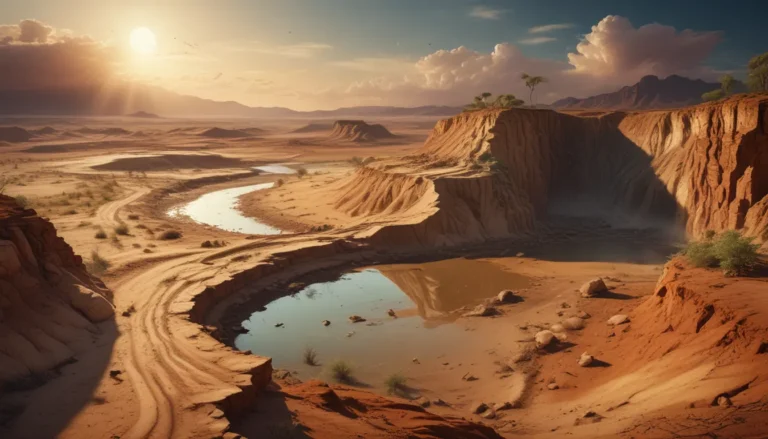A Note About Images: The images used in our articles are for illustration purposes only and may not exactly match the content. They are meant to engage readers, but the text should be relied upon for accurate information.
Have you ever wondered about the magic behind rainfall in mountainous regions? Orographic rainfall, a mesmerizing natural process, occurs when moist air ascends over mountains, resulting in clouds and precipitation. This meteorological phenomenon has intrigued scientists and nature enthusiasts due to its enigmatic nature and impact on local climates.
Join us on an educational journey as we unravel the mysteries of orographic rainfall and discover 11 captivating facts about this fascinating weather pattern. From its role in shaping landscapes to its influence on agriculture, we will explore the various facets of orographic rainfall that make it both mysterious and essential for our planet’s ecosystem.
Key Takeaways:
- Orographic rainfall, influenced by mountains, creates distinct climates on each side, impacting water resources, vegetation, biodiversity, and geographical features. – Orographic rainfall is crucial for water supply, agriculture, and natural beauty, but can also lead to flooding and landslides, influenced by climate change.
The Role of Geographic Features in Orographic Rainfall:
Orographic rainfall occurs when moist air is compelled to rise over mountain ranges or elevated terrains. As the air ascends, it cools, leading to condensation and cloud formation. This fundamental process is responsible for the mesmerizing orographic rainfall phenomenon.
Distinct Climate Patterns Created by Orographic Rainfall:
When moist air rises over a mountain, it cools and releases precipitation on the windward side, creating a lush environment. On the leeward side, the descending air warms up, resulting in dry conditions known as the rain shadow effect. This stark contrast in climate between the two sides of a mountain is a hallmark of orographic rainfall.
Crucial Role of Orographic Rainfall in Water Resources:
Orographic rainfall serves as a vital water source for rivers, lakes, and reservoirs, essential for irrigation, drinking water, and hydroelectric power generation. Its contribution to water supply is indispensable for various human activities and ecosystems.
Impact of Orographic Rainfall on Vegetation Distribution:
The different levels of precipitation facilitated by orographic rainfall influence the distribution of vegetation. The windward side of a mountain receives more rainfall, supporting lush forests, while the leeward side experiences arid conditions, fostering unique plant species. This disparity in precipitation levels shapes diverse ecosystems in mountainous regions.
Formation of Glaciers through Orographic Rainfall:
In regions with abundant orographic rainfall, excess precipitation can accumulate as snow and transform into glaciers over time. Glaciers serve as crucial freshwater sources and play a significant role in shaping landscapes through erosion, showcasing the dynamic interaction between orographic rainfall and geological processes.
Enhancing Biodiversity through Orographic Rainfall:
The microclimates created by orographic rainfall support a diverse range of plant and animal species, enhancing biodiversity in mountainous regions. This ecological richness results from the varied environmental conditions generated by orographic rainfall, showcasing nature’s resilience and adaptability.
Influence of Climate Change on Orographic Rainfall:
With global temperatures on the rise, changes in atmospheric circulation patterns can impact the occurrence of orographic rainfall. These changes have far-reaching consequences for water resources, vegetation distribution, and overall climate patterns in mountainous regions, highlighting the interconnectedness of environmental systems.
Global Presence of Orographic Rainfall:
From the majestic Himalayas to the awe-inspiring Andes, orographic rainfall is a common feature in mountain ranges worldwide. This natural phenomenon shapes local climates, influences biodiversity, and enriches the lives of communities dwelling in these regions, showcasing the universal significance of orographic rainfall.
Unique Geographic Features Shaped by Orographic Rainfall:
The erosive power of orographic rainfall over time results in the formation of breathtaking geological formations such as deep valleys, steep cliffs, and majestic waterfalls. These natural wonders not only attract tourists but also contribute to the beauty and diversity of mountain landscapes, illustrating the transformative impact of orographic rainfall on Earth’s geography.
Vital Role of Orographic Rainfall in Agriculture:
Many agricultural regions situated near mountain ranges benefit from orographic rainfall, as it provides a reliable water supply essential for plant growth. The agricultural activities supported by orographic rainfall contribute to local economies, showcasing the symbiotic relationship between nature and human livelihoods.
In conclusion, orographic rainfall, also known as relief rainfall, is a captivating natural process that shapes the weather patterns experienced in mountainous regions. By understanding the intricacies of orographic rainfall, we can gain valuable insights into the diverse ecosystems and unique landscapes found in these areas. The next time you witness rainfall in a mountainous region, take a moment to appreciate the intricate processes at play, reminding us of the profound connections between nature and our everyday lives.
FAQs on Orographic Rainfall:
Q: What causes orographic rainfall?
A: Orographic rainfall is triggered by moist air ascending over mountains, leading to cooling, condensation, and precipitation.
Q: Why does orographic rainfall occur on the windward side of mountains?
A: Orographic rainfall occurs on the windward side as moist air is forced to rise, resulting in cooling and moisture condensation.
Q: What is a rain shadow effect?
A: The rain shadow effect refers to dry air descending on the leeward side of mountains, causing reduced rainfall in that area.
Q: How does topography influence orographic rainfall?
A: Topographic features such as slope angle and elevation impact the intensity and distribution of orographic rainfall.
Q: Can orographic rainfall lead to flash floods?
A: Yes, intense orographic rainfall can trigger flash floods by overwhelming local drainage systems with excess precipitation.
Q: How does orographic rainfall impact agriculture?
A: Orographic rainfall provides essential water resources for agriculture in mountainous regions, supporting crop growth and sustaining livelihoods.
As we continue to explore the wonders of orographic rainfall, remember that each rainfall drop is a testament to the intricate beauty and interconnectedness of our natural world. Join us in celebrating the marvels of nature and the profound impact of orographic rainfall on shaping our environment and enriching our lives.






